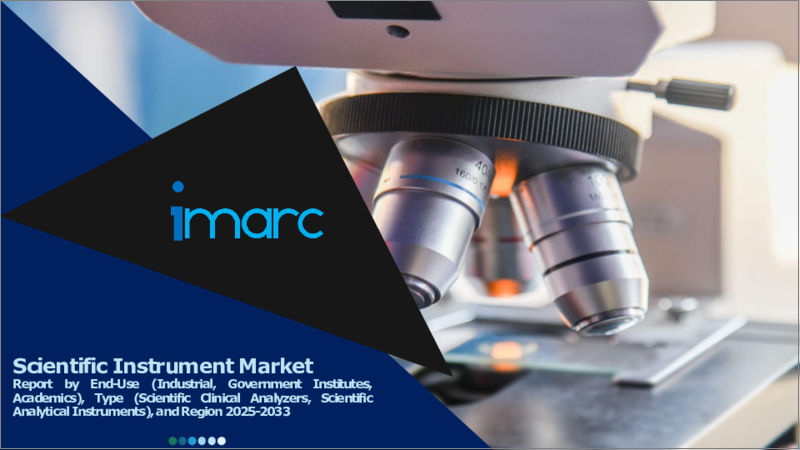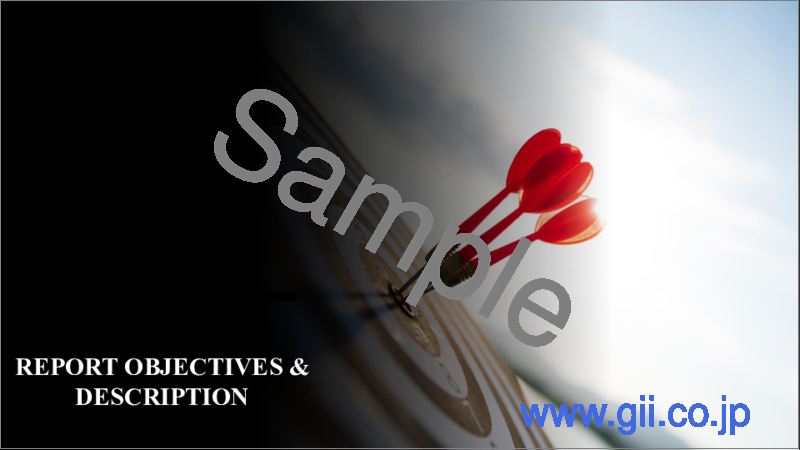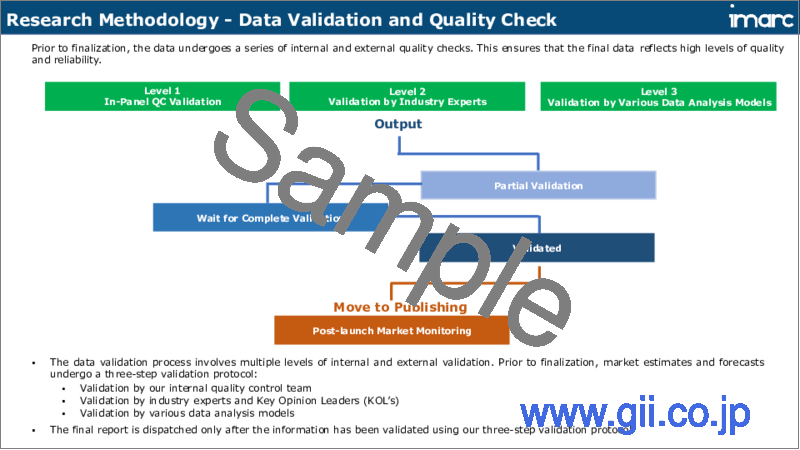|
|
市場調査レポート
商品コード
1661125
科学機器市場レポート:最終用途別、タイプ別、地域別、2025年~2033年Scientific Instrument Market Report by End-Use (Industrial, Government Institutes, Academics), Type (Scientific Clinical Analyzers, Scientific Analytical Instruments), and Region 2025-2033 |
||||||
カスタマイズ可能
|
|||||||
| 科学機器市場レポート:最終用途別、タイプ別、地域別、2025年~2033年 |
|
出版日: 2025年02月10日
発行: IMARC
ページ情報: 英文 140 Pages
納期: 2~3営業日
|
- 全表示
- 概要
- 図表
- 目次
科学機器市場の世界市場規模は2024年に462億米ドルに達しました。今後、IMARC Groupは、市場は2033年までに687億8,000万米ドルに達し、2025年から2033年にかけて4.48%の成長率(CAGR)を示すと予測しています。科学研究開発部門の拡大、政府や大学の研究室、その他様々な研究機関に最高の機器を提供するための政府とメーカーの協力関係の高まりが、市場成長を促進する主な要因の一つです。
科学機器とは、科学的な目的のために設計され、組み立てられ、改良された実験器具を指します。これらの機器には、電流計、気圧計、色差計、検流計、比重計、光度計、蓄音機などが含まれ、材料や元素の実証されていない特性や量を分析、測定、検証するために使用されます。科学機器は、新製品開発や既存製品の革新・改造の重要な構成要素となっています。現代では、研究機関も調査方法の最適な効率を達成するためにこれらの機器を使用しています。
世界の主要な需要促進は研究開発セクターの成長です。また、政府機関や大学の研究室、その他さまざまな研究機関に最適な機器を提供するために、政府とメーカーの協力関係が高まっていることも、世界全体の市場成長に寄与すると予測されています。さらに、科学機器とコンピュータの統合により、機器の機能が拡張・強化され、パラメータの調整と条件が提供され、データのサンプリング、収集、分解能、分析が合理化されます。これにより、科学機器の需要は世界的に拡大すると予想されます。
本レポートで扱う主な質問
- 2024年の世界の科学機器市場の市場規模は?
- 2025-2033年における科学機器市場の世界市場成長率は?
- 世界の科学機器市場を牽引する主要因は何か?
- 世界の科学機器市場に対するCOVID-19の影響は?
- 世界の科学機器市場の最終用途別内訳は?
- 世界の科学機器市場のタイプ別内訳は?
- 世界の科学機器市場における主要地域は?
- 世界の科学機器市場における主要企業は?
目次
第1章 序文
第2章 調査範囲と調査手法
- 調査の目的
- ステークホルダー
- データソース
- 一次情報
- 二次情報
- 市場推定
- ボトムアップアプローチ
- トップダウンアプローチ
- 調査手法
第3章 エグゼクティブサマリー
第4章 イントロダクション
- 概要
- 主要業界動向
第5章 世界の科学機器市場
- 市場概要
- 市場実績
- COVID-19の影響
- 価格分析
- 主要価格指標
- 価格構造
- マージン分析
- 市場内訳:最終用途別
- 市場内訳:タイプ別
- 市場内訳:地域別
- 市場予測
- SWOT分析
- 概要
- 強み
- 弱み
- 機会
- 脅威
- バリューチェーン分析
- 概要
- 研究開発
- 原材料調達
- 製造
- マーケティング
- 流通
- 最終用途
- ポーターのファイブフォース分析
- 概要
- 買い手の交渉力
- 供給企業の交渉力
- 競合の程度
- 新規参入業者の脅威
- 代替品の脅威
第6章 市場内訳:最終用途別
- 産業
- 市場動向
- 市場予測
- 政府機関
- 市場動向
- 市場予測
- 学術機関
- 市場動向
- 市場予測
第7章 市場内訳:タイプ別
- 科学的臨床分析装置
- 市場動向
- 市場予測
- 科学分析装置
- 市場動向
- 市場予測
第8章 市場内訳:地域別
- アジア太平洋地域
- 北米
- 欧州
- 中東・アフリカ
- ラテンアメリカ
第9章 科学機器製造プロセス
- 製品概要
- 原材料要件
- 製造工程
- 主要成功要因とリスク要因
第10章 競合情勢
- 市場構造
- 主要企業
- 主要企業のプロファイル
- Agilent Technologies Inc.
- Bruker Corporation
- Danaher Corporation
- Horiba Ltd.
- Thermo Fisher Scientific Inc.
- Waters Corporation
- F. Hoffmann-La Roche AG
- PerkinElmer Inc.
- Merck KGaA
List of Figures
- Figure 1: Global: Scientific Instrument Market: Major Drivers and Challenges
- Figure 2: Global: Scientific Instrument Market: Sales Value (in Billion USD), 2019-2024
- Figure 3: Global: Scientific Instrument Market: Breakup by End-Use (in %), 2024
- Figure 4: Global: Scientific Instrument Market: Breakup by Type (in %), 2024
- Figure 5: Global: Scientific Instrument Market: Breakup by Region (in %), 2024
- Figure 6: Global: Scientific Instrument Market Forecast: Sales Value (in Billion USD), 2025-2033
- Figure 7: Scientific Instrument Market: Price Structure
- Figure 8: Global: Scientific Instrument Industry: SWOT Analysis
- Figure 9: Global: Scientific Instrument Industry: Value Chain Analysis
- Figure 10: Global: Scientific Instrument Industry: Porter's Five Forces Analysis
- Figure 11: Global: Scientific Instrument (End Use in Industrial) Market: Sales Value (in Million USD), 2019 & 2024
- Figure 12: Global: Scientific Instrument (End Use in Industrial) Market Forecast: Sales Value (in Million USD), 2025-2033
- Figure 13: Global: Scientific Instrument (End Use in Government Institutes) Market: Sales Value (in Million USD), 2019 & 2024
- Figure 14: Global: Scientific Instrument (End Use in Government Institutes) Market Forecast: Sales Value (in Million USD), 2025-2033
- Figure 15: Global: Scientific Instrument (End Use in Academics) Market: Sales Value (in Million USD), 2019 & 2024
- Figure 16: Global: Scientific Instrument (End Use in Academics) Market Forecast: Sales Value (in Million USD), 2025-2033
- Figure 17: Global: Scientific Instrument (Clinical Analyzers) Market: Sales Value (in Million USD), 2019 & 2024
- Figure 18: Global: Scientific Instrument (Clinical Analyzers) Market Forecast: Sales Value (in Million USD), 2025-2033
- Figure 19: Global: Scientific Instrument (Analytical Instruments) Market: Sales Value (in Million USD), 2019 & 2024
- Figure 20: Global: Scientific Instrument (Analytical Instruments) Market Forecast: Sales Value (in Million USD), 2025-2033
- Figure 21: North America: Scientific Instrument Market: Sales Value (in Million USD), 2019 & 2024
- Figure 22: North America: Scientific Instrument Market Forecast: Sales Value (in Million USD), 2025-2033
- Figure 23: Europe: Scientific Instrument Market: Sales Value (in Million USD), 2019 & 2024
- Figure 24: Europe: Scientific Instrument Market Forecast: Sales Value (in Million USD), 2025-2033
- Figure 25: Asia Pacific: Scientific Instrument Market: Sales Value (in Million USD), 2019 & 2024
- Figure 26: Asia Pacific: Scientific Instrument Market Forecast: Sales Value (in Million USD), 2025-2033
- Figure 27: Middle East & Africa: Scientific Instrument Market: Sales Value (in Million USD), 2019 & 2024
- Figure 28: Middle East & Africa: Scientific Instrument Market Forecast: Sales Value (in Million USD), 2025-2033
- Figure 29: Latin America: Scientific Instrument Market: Sales Value (in Million USD), 2019 & 2024
- Figure 30: Latin America: Scientific Instrument Market Forecast: Sales Value (in Million USD), 2025-2033
- Figure 31: Scientific Instrument Manufacturing: Detailed Process Flow
List of Tables
- Table 1: Global: Scientific Instrument Market: Key Industry Highlights, 2024 and 2033
- Table 2: Global: Scientific Instrument Market Forecast: Breakup by End-Use (in Million USD), 2025-2033
- Table 3: Global: Scientific Instrument Market Forecast: Breakup by Type (in Million USD), 2025-2033
- Table 4: Global: Scientific Instrument Market Forecast: Breakup by Region (in Million USD), 2025-2033
- Table 5: Scientific Instrument: Raw Material Requirements
- Table 6: Global: Scientific Instrument Market: Competitive Structure
- Table 7: Global: Scientific Instrument Market: Key Players
The global scientific instrument market size reached USD 46.2 Billion in 2024. Looking forward, IMARC Group expects the market to reach USD 68.78 Billion by 2033, exhibiting a growth rate (CAGR) of 4.48% during 2025-2033. The expanding scientific R&D sector and rising collaboration between the governments and manufacturers to provide the best instruments in government and university laboratories, and various other research institutions are some of the key factors driving the market growth.
Scientific instruments refer to laboratory equipment which are designed, constructed and refined for scientific purposes. These instruments include ammeter, barometer, chromometer, galvanometer, hydrometer, photometer, phonograph, etc. which are used for analysing, measuring and verifying the unproven properties and quantities of a material or an element. Scientific instruments form an important component of new product development and innovating and remodelling the existing products. In modern times, research institutes use these instruments to achieve optimum efficiency in their research processes as well.
The major demand driver of the global scientific instrument market is the growth of the research and development sector. Additionally, the rising collaboration between the governments and manufacturers to provide the best instruments in government and university laboratories, and various other research institutions is anticipated to contribute to the market growth across the globe. Further, the integration of scientific instruments with computers extends and enhances instrumental functions, offers parameter adjustments & conditions and streamlines data sampling, collection, resolution & analysis. This is expected to expand the demand for scientific instruments worldwide.
Key Market Segmentation:
Breakup by End-Use:
- Industrial
- Government Institutes
- Academics
Based on the end-use sectors, the report has segregated the market as industrial, government institutes and academics. Currently, industrial users dominate the market, accounting for the largest share.
Breakup by Type:
- Scientific Clinical Analyzers
- Scientific Analytical Instruments
On the basis of type, the market has been segmented into scientific clinical analyzers and scientific analytical instruments. Amongst these, scientific clinical analyzers are the most popular type, holding the majority of the market share.
Breakup by Region:
- North America
- Europe
- Asia Pacific
- Middle East & Africa
- Latin America
The report has segmented the global scientific instruments market on the basis of region into North America, Europe, Asia Pacific, Latin America, and Middle East & Africa.
Competitive Landscape:
The competitive landscape of the market has also been examined with some of the key players being Agilent Technologies Inc., Bruker Corporation, Danaher Corporation, Horiba Ltd., Thermo Fisher Scientific Inc., Waters Corporation, F. Hoffmann-La Roche AG, PerkinElmer Inc. and Merck KGaA.
This report provides a deep insight into the global scientific instrument market covering all its essential aspects. This ranges from macro overview of the market to micro details of the industry performance, recent trends, key market drivers and challenges, SWOT analysis, Porter's five forces analysis, value chain analysis, etc. This report is a must-read for entrepreneurs, investors, researchers, consultants, business strategists, and all those who have any kind of stake or are planning to foray into the scientific instrument market in any manner.
Key Questions Answered in This Report
- 1.What was the size of the global scientific instrument market in 2024?
- 2.What is the expected growth rate of the global scientific instrument market during 2025-2033?
- 3.What are the key factors driving the global scientific instrument market?
- 4.What has been the impact of COVID-19 on the global scientific instrument market?
- 5.What is the breakup of the global scientific instrument market based on the end-use?
- 6.What is the breakup of the global scientific instrument market based on the type?
- 7.What are the key regions in the global scientific instrument market?
- 8.Who are the key players/companies in the global scientific instrument market?
Table of Contents
1 Preface
2 Scope and Methodology
- 2.1 Objectives of the Study
- 2.2 Stakeholders
- 2.3 Data Sources
- 2.3.1 Primary Sources
- 2.3.2 Secondary Sources
- 2.4 Market Estimation
- 2.4.1 Bottom-Up Approach
- 2.4.2 Top-Down Approach
- 2.5 Forecasting Methodology
3 Executive Summary
4 Introduction
- 4.1 Overview
- 4.2 Key Industry Trends
5 Global Scientific Instrument Market
- 5.1 Market Overview
- 5.2 Market Performance
- 5.3 Impact of COVID-19
- 5.4 Price Analysis
- 5.4.1 Key Price Indicators
- 5.4.2 Price Structure
- 5.4.3 Margin Analysis
- 5.5 Market Breakup by End-Use
- 5.6 Market Breakup by Type
- 5.7 Market Breakup by Region
- 5.8 Market Forecast
- 5.9 SWOT Analysis
- 5.9.1 Overview
- 5.9.2 Strengths
- 5.9.3 Weaknesses
- 5.9.4 Opportunities
- 5.9.5 Threats
- 5.10 Value Chain Analysis
- 5.10.1 Overview
- 5.10.2 Research and Development
- 5.10.3 Raw Material Procurement
- 5.10.4 Manufacturing
- 5.10.5 Marketing
- 5.10.6 Distribution
- 5.10.7 End-Use
- 5.11 Porters Five Forces Analysis
- 5.11.1 Overview
- 5.11.2 Bargaining Power of Buyers
- 5.11.3 Bargaining Power of Suppliers
- 5.11.4 Degree of Competition
- 5.11.5 Threat of New Entrants
- 5.11.6 Threat of Substitutes
6 Market Breakup by End-Use
- 6.1 Industrial
- 6.1.1 Market Trends
- 6.1.2 Market Forecast
- 6.2 Government Institutes
- 6.2.1 Market Trends
- 6.2.2 Market Forecast
- 6.3 Academics
- 6.3.1 Market Trends
- 6.3.2 Market Forecast
7 Market Breakup by Type
- 7.1 Scientific Clinical Analyzers
- 7.1.1 Market Trends
- 7.1.2 Market Forecast
- 7.2 Scientific Analytical Instruments
- 7.2.1 Market Trends
- 7.2.2 Market Forecast
8 Market Breakup by Region
- 8.1 North America
- 8.1.1 Market Trends
- 8.1.2 Market Forecast
- 8.2 Europe
- 8.2.1 Market Trends
- 8.2.2 Market Forecast
- 8.3 Asia Pacific
- 8.3.1 Market Trends
- 8.3.2 Market Forecast
- 8.4 Middle East & Africa
- 8.4.1 Market Trends
- 8.4.2 Market Forecast
- 8.5 Latin America
- 8.5.1 Market Trends
- 8.5.2 Market Forecast
9 Scientific Instrument Manufacturing Process
- 9.1 Product Overview
- 9.2 Raw Material Requirements
- 9.3 Manufacturing Process
- 9.4 Key Success and Risk Factors
10 Competitive Landscape
- 10.1 Market Structure
- 10.2 Key Players
- 10.3 Profiles of Key Players
- 10.3.1 Agilent Technologies Inc.
- 10.3.2 Bruker Corporation
- 10.3.3 Danaher Corporation
- 10.3.4 Horiba Ltd.
- 10.3.5 Thermo Fisher Scientific Inc.
- 10.3.6 Waters Corporation
- 10.3.7 F. Hoffmann-La Roche AG
- 10.3.8 PerkinElmer Inc.
- 10.3.9 Merck KGaA






